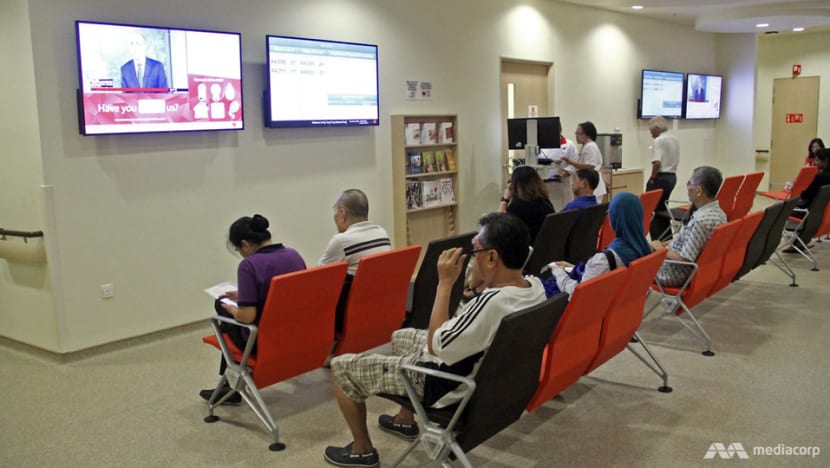Commentary: What more can we do to stop abusive behaviour towards healthcare workers?
Han Feizi was recently jailed for abusive behaviour towards a hospital employee. Beyond this viral incident, it’s disturbing how much abuse healthcare workers in Singapore face, says Singapore University of Social Sciences’ Victor Seah.

Chinese national Han Feizi was embroiled in three separate incidents including an intoxicated series of arguments with hospital staff and the police at Singapore General Hospital after a Grab driver purportedly ran over her foot. (Photos: Douyin)

This audio is generated by an AI tool.
SINGAPORE: Think “everyday hero” and nurses and other healthcare workers likely come to mind. Yet, our heroes face a growing problem of abuse.
Recently, 29-year-old Chinese national Han Feizi went viral for videos of her arguing with the police, after she swore at nurses and raised a ruckus at the Singapore General Hospital. She was charged for using abusive words on a hospital employee among other offences, and has since been jailed, fined and deported.
It’s sadly an experience that healthcare workers in Singapore are all too familiar with. More than two in three healthcare workers engaged by a tripartite workgroup had witnessed or personally experienced abuse in the past year - a third of all workers did so at least once a week.
From 2018 to 2022, the number of police reports of abuse or harassment of public healthcare workers who were on duty, and the number of warnings issued, have also increased.
It reminds us that even in a society that highly values its healthcare workers, there are individuals who resort to aggression and mistreatment. Verbal abuse is the most common form of non-physical violence (about 60 per cent to 70 per cent), according to research.
The effects of verbal abuse and other forms of workplace violence on healthcare workers are well-documented and include increased turnover, resignations, burnout, emotional exhaustion, depression, anxiety and even suicidal thoughts.
PAIN, FRUSTRATION, POWERLESSNESS
It seems bewildering to hurt the very people whose care and expertise we seek to heal and help us.
But to address healthcare worker abuse, it is useful to understand the mindset of those who resort to abuse. Patients and their loved ones may lash out because of pain and frustration, a sense of powerlessness, and even possibly, a lack of trust in healthcare workers and system.
Studies have long found a link between feeling pain and displays of aggression. Some incidents of abuse may be triggered by patients or their visitors displacing or redirecting their anger and frustration onto healthcare workers in the heat of the moment.
Some important healthcare decisions, like evaluations concerning the seriousness of medical conditions, can be seen as subjective and outside of one’s control. For something as personal as one’s health, it can feel like decisions about care and interventions - such as how long the wait is to see the doctor - are outside of one’s control. Those who may not be comfortable speaking in English may also feel that they are not well understood.
Consequently, and often in a heightened emotional state, this may lead to a perverse form of problem solving: Patients and their kin seek to regain a sense of control by harassing the healthcare worker making such decisions, such as pressuring nurses into prioritising their treatment over other patients, and this can spiral out of hand into abuse.
COMBATING HEALTHCARE WORKER ABUSE
How do we address healthcare worker abuse? The Ministry of Health, informed by the Tripartite Workgroup for the Prevention of Abuse and Harassment, is due to release details of efforts to combat healthcare worker abuse before the end of the year.
This might include discharging abusive patients who do not require urgent medical care and having clear and common definition of abuse and harassment. Such multicomponent interventions involving all stakeholders, with a focus on both healthcare workers and perpetrators, have been found to be more effective than standalone interventions such as communication training or providing more security personnel.
Other interventions worth considering include those that seek to prevent incidents from occurring in the first place, and those that can help foster a culture of speaking up.
I propose a few here with a disclaimer that these ideas need to be tested in the specific context before full-scale implementation. Behavioural change interventions can fail or even backfire if not tested before deployment.
Interventions that seek to prevent incidents from occurring in the first place should be the main goal of any anti-abuse efforts. The adage “prevention is better than cure” applies here. But such interventions would likely have to be context specific and driven by data.
For example, a hospital may find a heightened risk of abuse by those visiting a patient during their first night of ward admission, when anxieties run high while tests are being run. One intervention could happen during the visitor registration process, asking them to affirm their support of safe workplaces for healthcare workers.
Behavioural studies suggest that explicitly responding to a prompt can act as a reminder and may also commit visitors to behaving respectfully.

NOT NORMAL TO BE ABUSED AT WORK
Worryingly, findings from the tripartite workgroup engagement indicate that healthcare workers have to some extent, normalised the abuse they encounter. For instance, whereas 77 per cent of the public regard shouting and threats to cause harm as abuse, only 66 per cent of healthcare workers polled felt so.
Furthermore, healthcare workers were found to under-report incidents of abuse, with only 24 per cent of incidents reported to their institution.
Clearly, interventions to create a culture of speaking up are needed. These include video presentations, workshops, simulations and role-playing exercises.
Creating a culture of speaking up is difficult and interventions often fail. Part of this may be attributed to healthcare workers’ desire to be compassionate and empathetic, even in the face of abuse.
Another important element is to ensure healthcare workers feel like their leaders have their back. A fear of being seen by supervisors as overreacting is a key reason why healthcare workers do not report incidents.
When told of an incident, leaders should avoid dismissing complaints or ridiculing complainants. They should tell complainants that their reporting is taken seriously and that no reporting that is done in good faith would lead to any adverse outcomes.
The recent attention to healthcare worker abuse is an opportunity for healthcare leaders to emphasise their zero tolerance for abuse and reaffirm their commitment to workers’ safety and well-being.
When my son contracted meningitis just after his full month (man yue 满月) celebration, moments of light during this difficult time came from the empathy and care of the staff at KK Women’s and Children’s Hospital.
Many of us have been touched by their dedication and professionalism. We owe it to them to report when we witness abuse. Healthcare workers should not feel like it is normal to be abused at work or see it as something they just have grin and bear with.
Dr Victor Seah is Acting Director, Centre of Excellence for Behavioural Insights at Work (BI@Work), Singapore University of Social Sciences (SUSS).



















